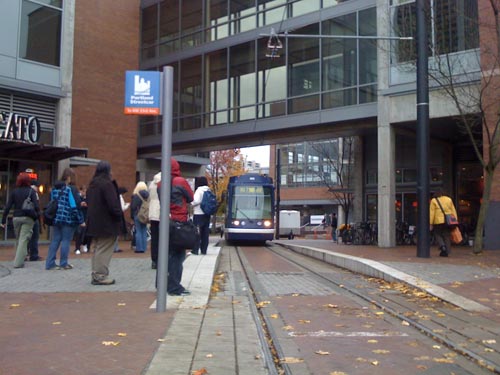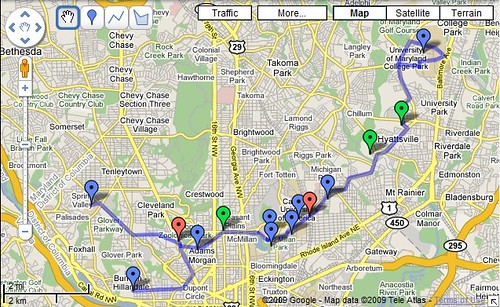Routing for the streetcar in Portland, after a recent extension of the line, now goes through the campus of Portland State University. Image from the Planologie blog.
I have written before about how systematic transportation demand management planning can be hit or miss for college campuses. It appears to be dependent on how strong are local or state laws directing that colleges and universities do comprehensive transportation planning.
In Maryland, the state requirements for updating college campus master plans every 5 years are somewhat quiet about transportation generally and for coordinating with local jurisdictions. So some universities, like Towson State University, are doing a great job--driven more by concerns and commitments to sustainability rather than great transportation planning, and others like University of Maryland Baltimore County, are still focused on being commuter-driven and focused on the car. (I only know about these campuses because when I was doing the Western Baltimore County Pedestrian and Bicycle Access Plan, and had to deal with these institutions which were either within or bordering the plan area.)
Most of the DC universities are somewhat weak as it relates to transportation, although many have active shuttle systems, especially Georgetown University and American University. GWU and Catholic University benefit from having subway stops on or immediately abutting their campuses.
NotionsCapital calls our attention to George Mason University, which on their Arlington campus has a transportation and logistics master's program, although that doesn't seem to have influenced the main campus' decision to engage more actively with local jurisdictions to coordinate transportation planning. From "
A Road Through the County" from the
Inside Higher Education newsletter:
George Mason began to include the surrounding areas in its transportation planning process and how that effort paid off -- to the tune of an additional $15 million in state support to build a new campus road, as well as better relations between the university and community.
Unlike businesses that are subject to the control of the county or city in which they reside, GMU is an autonomous state institution, meaning that it doesn’t have to answer to the surrounding community when it wants to expand enrollment or do anything within its property. And historically it has made its decisions with little input from the community.Entries in
Greater Greater Washington about the campus planning processes in DC at GU and AU demonstrate that DC could do a better job of guiding the campus planning process generally and the transportation demand management element specifically. Efforts at GMU and UMD College Park (and Towson University) show a better way forward.
Many transit systems have discount passes available for college students,
including Baltimore's MTA. Some campus bus systems allow nonstudents to ride, such as at Central Washington State University in Ellensburg, WA, and, with restrictions, the UMD College Park system does too, including from the Metro station to the campus. Better coordination of campus shuttle systems (although they have issues in terms of "common carrier" laws) could assist many communities in extending transit service in a cost-effective manner.
Map of the proposed University (Crosstown) Streetcar Line for Washington DC (with service to University of Maryland in Prince Georges County).
I did a couple presentations at Towson in 2010 (at the Sustainability conference and for a class) but I don't have them online. I do need to reformulate the presentation to be a bit more general rather than being more specifically about Baltimore County.
Labels: transportation planning, university transit, university-community revitalization






1 Comments:
Thank you for a very informative articles.
Post a Comment
<< Home